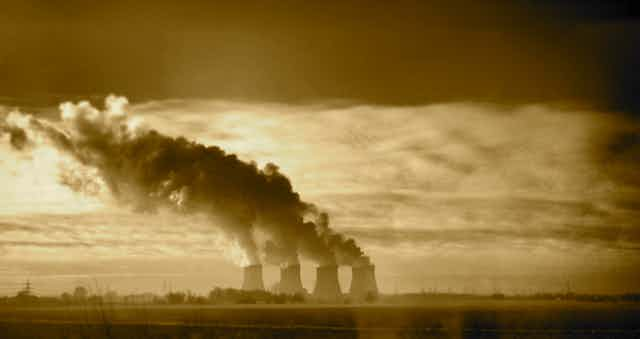Growth in global carbon emissions is slowing, but is still more than enough to increase global temperatures by more than 2C, according to a report released today by the Global Carbon Project. Carbon emissions increased by 2.1% to 9.7 billion tonnes in 2012, lower than the average increase of the past decade.
Experts say any fall in growth is good news, but to keep warming under the international safety threshold of 2C much greater action will be needed.
The carbon cycle report, a synthesis of studies from research institutions around the world, predicts total carbon emissions will increase by a further 2.1% in 2013 to 9.9 billion tonnes.
Coincident with the report the Global Carbon Project also released a nation-by-nation breakdown of carbon emissions. The four biggest emitters in 2012 were China (contributing 27% of emissions), the US (14%), the EU (10%), and India (6%). Developing nations combined emitted 57% of CO2.
Slowing growth was driven largely by significant climate action in the US and EU. The US reduced emissions by 3.7% in 2012, while the EU made cuts of 1.3%.
India and China are leading the way on emissions growth, increasing emissions by 7.7% and 5.9% respectively.
Australian emissions, according to March 2013 data from the Department of Environment used in the report, have remained almost constant over the past year.
The coal industry was the greatest source of carbon emissions, contributing 43% to the year’s carbon budget, followed by oil (33%), gas (18%), cement (5.3%), and gas flaring (0.6%). Emissions from land use change, such as deforestation and land clearance, are declining.
The report also assessed how much atmospheric carbon increased, finding that growth in atmospheric CO2 in 2012 was higher than average, increasing to 393 parts per million. Growth in 2010 and 2011 was lower than average thanks to La Niña conditions and increased uptake of CO2 by the land.
Annually more than half of carbon emissions are absorbed by land and ocean, with the remainder going into the atmosphere. Uptake of carbon by the land is one of the greatest uncertainties in carbon projections for the future.
Burning our global carbon quota
Dr Michael Raupach at CSIRO and an author on the report said the findings are “absolutely frightening”. Current trends match the highest emissions scenario used by the International Panel on Climate Change, setting the world on track for catastrophic warming of 3.2-5.4C by 2100.
“According to figures in the IPCC fifth assessment report, the total amount of CO2 emissions allowed to stay below 2C is somewhere around 850 billion tonnes of carbon from the start of the Industrial Revolution.”
The world has to date emitted 550 billion tonnes of carbon, leaving roughly 300 billion tonnes to emit to have any chance of keeping warming below 2C. With global emissions at 10 billion tonnes every year, Dr Raupach estimates we have 30 years before the entire world has to stop emitting carbon “cold turkey”.
“If we want to meet the target it will mean rapid decreases from now of several per cent per year until we get down to one third of current emissions in 30 years time. Then we’ve still got some of our quota left to use for carbon emissions we can’t avoid.”
Emissions savings
Dr Raupach said energy conservation measures in Europe and transition to solar, wind, hydro and nuclear energy were behind cuts to emissions.
Domestic manufacturing in Europe and the US has also moved offshore to China, decreasing domestic emissions but increasing China’s.
Dr Barry Naughten, energy economist at Australian National University, said the US shale gas revolution and closing inefficient coal-fired power stations is driving falling emissions in that country. But he warned outlooks from the US Energy Information Agency (EIA) show minor cuts to emissions by 2040.
“In 2005 peak emissions were 6 billion tonnes CO2. Historical data indicates a sharp fall from 2005 level to 5.5 billion tonnes CO2 in 2009-2010, reflecting the economic recession as well as fuel switching and efficiency measures. Projections then indicate an increase from 2011 to 5.7 billion tonnes CO2 in 2040.”

